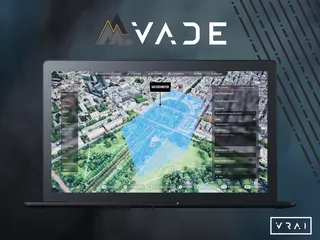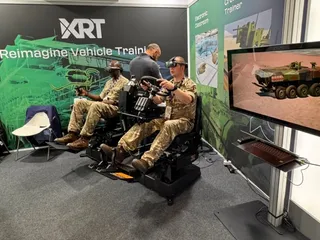Cross-over Technologies
Contact Our Team
For more information about how Halldale can add value to your marketing and promotional campaigns or to discuss event exhibitor and sponsorship opportunities, contact our team to find out more
The Americas -
holly.foster@halldale.com
Rest of World -
jeremy@halldale.com

Group Editor Marty Kauchak reports from the 2012 I/ITSEC on products and systems which have the potential to support civil aviation sector training audiences.
The 2012 I/ITSEC once again allowed the military training community to see and learn about the simulation and training industry’s latest technology innovations in the different training domains. A number of technologies and their applications showcased at the conference for the military sector have applicability for civil aviation community aircrews and maintenance personnel throughout their learning continua.
Mobile Learning Devices
There was quite a buzz on the exhibition floor about the new mobile learning devices unveiled for maintenance technicians and other occupational groups.
One new product which caught our attention was a mobile solution from Lockheed Martin. The company is innovating mobile training applications to provide platform operators with immediate, affordable resources to help keep equipment running. On a tablet device, an operator scans a product barcode, quick response code or nameplate. The app then identifies the equipment and securely returns maintenance, operating, troubleshooting and repair information in the form of highly interactive 3D models.
Pat Allen, a business development executive at Lockheed Martin Mission Systems and Training, explained the operator can take a photo or video of the problem, generate annotation and immediately transmit the information to stakeholders such as a safety center or technical advisor. In addition, operators can use video conferencing to consult with advisors in other locations.
Connectivity to maintenance databases and supporting logistics systems is provided, resulting in a single application to perform the majority of operator tasks.
Allen pointed out that his company’s mobile app technology is the first of its kind, with two patents pending. “Several things make this an innovative technology, but most importantly, Lockheed Martin has developed a total mobile solution that provides the applications, connectivity to the cloud environment and comprehensive security in ways not previously developed. The key with this technology is to make learning more intuitive so that operators can quickly grasp how to maintain or fix a component,” Allen said.
Lockheed Martin also develops mobile apps that replace traditional technical manuals to provide a searchable and easily updated reference. These apps include advanced 3D models and embedded learning science that allow them to become learning and teaching tools as well as serve as traditional technical manuals.
Allen said mobile apps are “true chameleons – they can adapt to the platform and training requirements.” Originally developed for military training, Lockheed Martin is expanding the capability to other markets including the energy and civil aviation industries. The apps are underpinned by the same learning.
NGRAIN’s new Augmented Reality (AR) capabilities hold potential for taking virtual reality and placing it in the learning environment for civilian aviation maintainers. CAT participated in an AR demonstration application in which the learner was able to view a piece of equipment through an iPad’s window, seeing and accessing information about key equipment including 2D and 3D graphical overlays, video, text and other content.
While Gabe Batstone, the company’s CEO, said the capability is an emergent technology innovation capability, it is more than a concept. “We have developed a robust prototype but need market feedback to ensure our future product solves real business problems,” he said.
Batstone also pointed out that the AR initially emphasizes maintenance training applications and would conceivably allow civilian aviation maintainers to learn and rehearse skills through their continuum of learning.
Motion Systems and Visual Displays
CAT has watched Moog help to rapidly advance the state-of-the-art in electric motion systems. The company’s products are found in military and civilian training centers around the globe.
After achieving quantum leaps to improve the fidelity of electric motion systems in the full motion simulator system, Moog is unveiling a number of cutting-edge technology refinements.
Charles F. Bartel, Jr., the company’s product application manager for simulation, noted the features and benefits presented at I/ITSEC are small steps of improvement that provide more tools that have been asked for by the current community of users. As significant, the industry veteran said “the new safety regulations that have gone into effect which, among other items, required the integration of a safety programmable logic controller, have been addressed. Maintenance software has added features to make it more deterministic, i.e., error messages are more explicit than in the past. For instance, all fuses and circuit breakers are monitored, and should one fail, rather than a general fault that would indicate a failure, an error note identifies which component has failed and needs replacement/reset.”
The company is similarly reducing maintenance time on its systems. Bartel continued, “In the current production unit, it might take maintenance 15 minutes to a one-half hour to find the open fuse. In the new system it will take only a few minutes to read the error message, get a fuse, and replace it. Other maintenance issues will be similar in time reduction.”
Bartel also pointed out yet another technology refinement – where one of the major issues in the actuator was the elimination of the Ni (nitrogen)-based snubber design. “Not only does it reduce maintenance activity, but eliminates a high pressure gas storage issue,” he concluded.
Thales generated a constant flow of visitors to its booth when it unveiled the Reality H helicopter simulator. The device is equipped with a new, all-electric Hexaline high-fidelity, six axis linear motion system.
The direct-projection visual system offers a 210 degree (horizontal) x 70 degree (vertical) field of view with imagery from the ThalesView image generator.
The device which has applicability to train aircrews in the challenging offshore oil and gas operations, emergency medical services and other civil aviation sectors, has achieved certification by the French civil aviation authority (DGAC) in line with European Air Safety Agency’s CS-FSTD(H) standards.
The visual display sector is stepping up its efforts to deliver systems which create displays with ever increasing levels of fidelity. At the 2011 I/ITSEC CAT observed projectiondesign launch its FL35 series of projectors. The product has up to 4.1 Megapixel resolution and second generation solid-state ReaLED illumination. At the 2012 conference, Maria Dahl Aagaard, the company’s product marketing manager, reported the FL35 series of LED projectors has achieved massive interest and success, particularly in full flight Level D simulators for commercial aviation audiences around the globe. “They are applauded as 'the' projector to achieve both realism and low total cost of ownership. The success of the FL35 is providing very popular with customers valuing the hassle free operation of the visual system. Particularly interesting is the 2560 x 1600 pixel resolution, as not only does it allow for details being apparent at a greater distance, but it is the only way to achieve 45 degrees vertical field of view.”
Projectiondesign also introduced its new FS35 IR series projector at the 2012 I/ITSEC. The new projector is a continuation of the solid-state ReaLED illumination projector range of up to WQXGA resolution. Dahl Aagaard pointed out the FL35 incorporates a fourth infra-red (IR) LED making it possible to operate in the near-IR spectrum, stimulating night vision goggles. “It shares the same features as the FL35 series of projectors, but with the ability to simultaneously output IR and visual light through dual channel inputs coming from two image generators, in which one would send content in the visible light spectrum, whilst the other in the near infrared spectrum; or output IR and visual content through one single input of up to 4.1 Megapixels,” she explained.
The company executive noted the FS35 IR has generated significant, early interest in the military training community. Barco, another company in this sector, introduced its SIM 7Q-HC simulation projector. The device has enhanced contrast ratio (40,000:1) at 2,800 lumens to better support flight training and in particular night-time scenarios.


